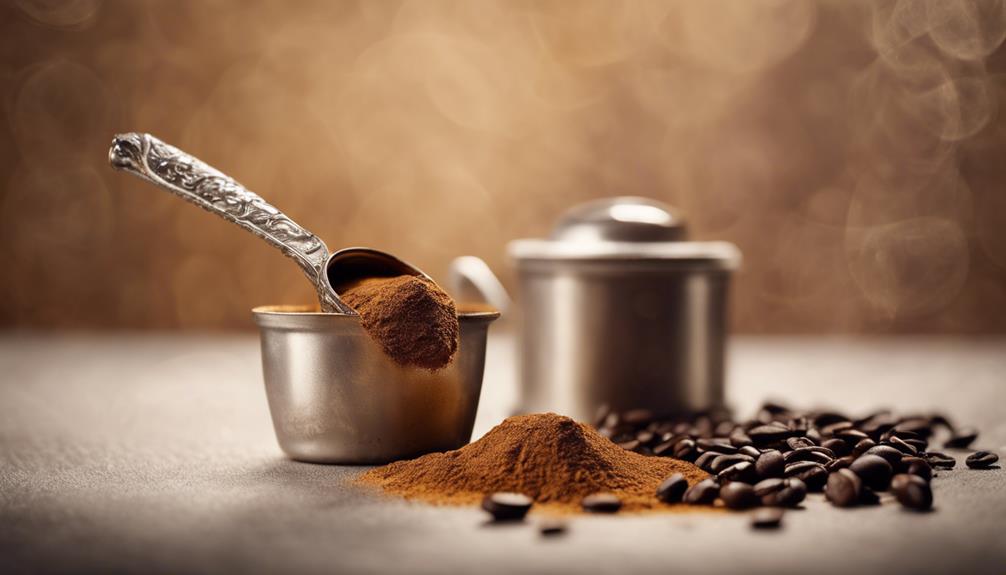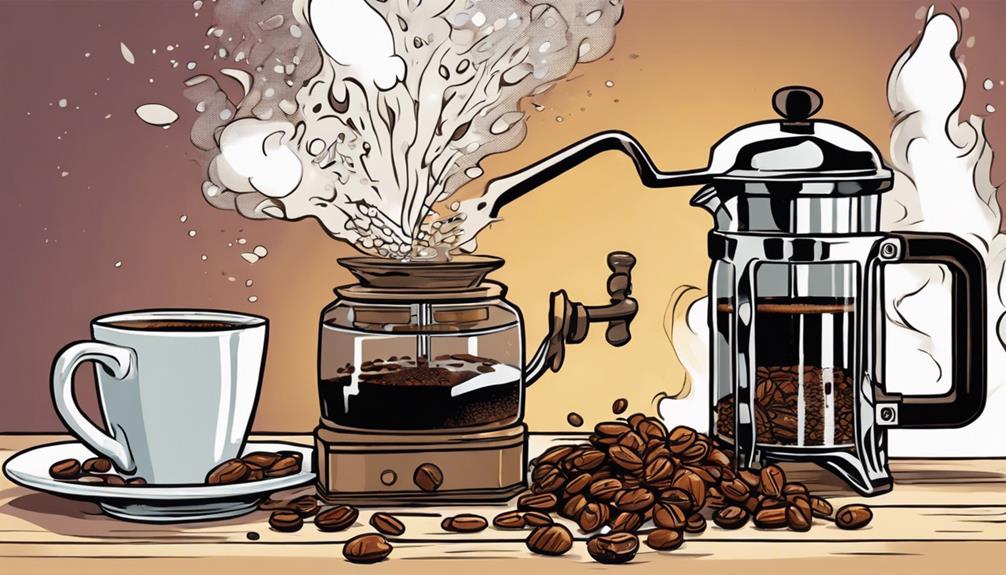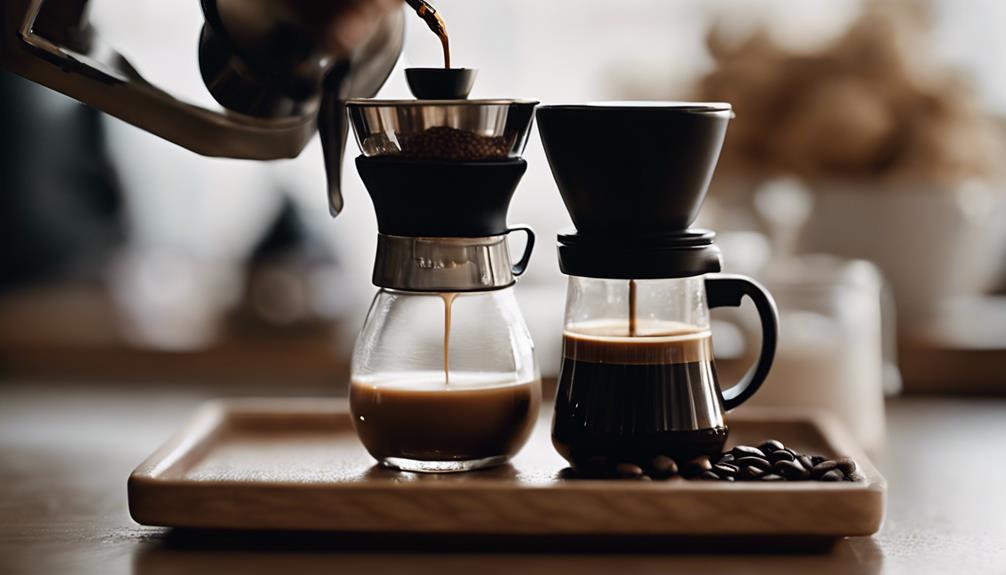You are about to uncover the potential of espresso powder, a concentrated coffee flavor that easily dissolves into liquids, providing depth and richness to your baked goods and savory dishes. Essentially, it is brewed espresso that has been dehydrated into fine flakes, making it simple to incorporate a rich coffee flavor into your recipes. With its extended shelf life and versatility, espresso powder can revolutionize any recipe. Whether you want to enhance the chocolate flavor, boost spice rubs, or add an extra kick to your smoothies, espresso powder is the ideal addition – and you are just scratching the surface of its possibilities.
Key Takeaways
- Espresso powder is brewed espresso that has been dehydrated, resulting in a concentrated coffee flavor that dissolves easily in liquids.
- It provides a quick and cost-effective way to incorporate coffee flavor into recipes, allowing for small amounts to elevate flavors.
- Espresso powder is more concentrated than instant coffee, with a smoother flavor profile, and requires smaller amounts for flavor.
- It can be used in both sweet and savory dishes, enhancing chocolate flavor in desserts and adding depth to spice rubs and marinades.
Understanding Espresso Powder
You likely encounter espresso powder as a mysterious ingredient in recipes, but understanding what it is and how it's made can demystify its role in amplifying flavors. Espresso powder is made from darkly roasted coffee beans that are ground into a fine powder. It is used to enhance the chocolate flavor in baked goods and desserts, and can also be used as a substitute for instant coffee. When baking with espresso powder, it is important to use it sparingly, as the flavor can be quite strong.
Fundamentally, espresso powder is brewed espresso that's been dehydrated, resulting in a concentrated coffee flavor that dissolves easily in liquids. Unlike traditional instant coffee, espresso powder appears as soft flakes, making it quick and convenient to use in recipes.
When you use espresso powder, you can expect it to enhance the overall flavor profile of your dishes, whether sweet or savory. In baking, it functions similarly to salt, amplifying flavors without imparting a distinct coffee taste unless used in larger quantities.
The recommended usage varies depending on the recipe size and desired taste, ranging from 1/4 teaspoon for subtle flavor enhancement to 1 tablespoon for a pronounced coffee flavor.
With this understanding, you'll be able to harness the power of espresso powder to elevate your recipes and reveal new depths of flavor. By incorporating this ingredient thoughtfully, you can create dishes that are rich, complex, and tantalizing to the taste buds.
Benefits of Using Espresso Powder
With its versatility and convenience, espresso powder offers several benefits that make it a valuable addition to your pantry. For one, it provides a quick and convenient way to incorporate coffee flavor into your baked goods without the need for brewing time.
Plus, its concentrated flavor means you only need small amounts to greatly enhance the taste, making it a cost-effective ingredient.
When used in chocolate desserts, espresso powder can elevate the overall flavor profile without imparting a strong coffee taste, creating a rich and balanced dessert. Additionally, it has a long shelf life when stored properly, ensuring its flavor remains intact over time for repeated use in recipes.
But espresso powder's benefits don't stop at baking; it can also be used in savory dishes, adding depth to spice rubs and marinades. This showcases its versatility beyond just baking.
How to Make Espresso Powder

Brewing espresso beans is the first step in creating your own espresso powder at home. You'll need to dehydrate the brewed beans at low temperatures until they become crunchy. This process will yield about 1 cup of espresso powder from 1 cup of espresso beans when ground to a fine consistency.
Once you've dehydrated the beans, let them cool completely before grinding to prevent moisture from affecting the powder's texture. For the best results, use a burr grinder to achieve a uniform powder consistency. If you don't have a burr grinder, you can use a food processor, but be cautious not to transfer flavors.
When grinding, aim for a fine powder that will incorporate smoothly into recipes without any graininess. You'll know you've reached the right consistency when the powder feels silky to the touch.
With your freshly made espresso powder, you're now ready to elevate your baking and cooking creations. Remember, the key to making high-quality espresso powder is to brew, dehydrate, cool, and grind with precision.
Uses for Espresso Powder
Espresso powder's versatility in the kitchen is remarkable, and its unique flavor profile makes it an excellent addition to a variety of sweet and savory dishes. You can use it to intensify the flavor of chocolate desserts, like brownies and cakes, without overpowering them with a strong coffee taste. It's also a great addition to savory dishes, adding depth to spice rubs and marinades, and enriching the flavor of roasted meats and gravies.
When you incorporate espresso powder into frostings, dissolving 1 tablespoon in cream or water enhances the overall taste profile of cakes and cupcakes. Its ability to dissolve easily in liquids guarantees a smooth texture in batters and mixtures, making it a versatile ingredient for both baking and beverages.
You can even add it to smoothies and other drinks for a quick and concentrated coffee flavor, providing an extra caffeine kick without brewing. Whether you're using instant espresso powder or the regular kind, its uses are endless, and it's sure to become a staple in your pantry.
Substitutes for Espresso Powder

Now that you're familiar with the uses of espresso powder, you're probably wondering what to do if you don't have it on hand.
Fortunately, you can turn to some reliable substitutes that'll get you close to the real deal.
You'll need to know how to adjust the quantities and conversions to get the flavor just right, and we'll walk you through those details.
Alternative Options
In a pinch, you can turn to alternative options that mimic the rich flavor of espresso powder, although some adjustments may be necessary to get the taste just right.
One such option is instant coffee, which can serve as a substitute, but keep in mind it's less concentrated. You'll need about 1 1/2 tablespoons of instant coffee for every tablespoon of espresso powder called for in a recipe.
If you're looking for a more precise substitution, Moccona Espresso Style instant coffee granules are a great alternative. Use 1 tablespoon plus 1/2 teaspoon of granules for every tablespoon of espresso powder, and dissolve them in just-boiled water at a 1:1 ratio.
Other effective substitutes include Bushells Turkish Style pulverized coffee and Nescafe Short Black instant coffee powder.
Remember to adjust the quantities based on your personal taste preferences and the recipe's requirements, as the strength of coffee flavor can vary by brand.
Be cautious when using regular instant coffee, as it may impart a harsher flavor compared to the typically smoother taste of espresso powder.
Espresso Powder Substitutes
Turning to alternatives, you'll find that several options can mimic the rich flavor of espresso powder, each with its own strengths and weaknesses.
Instant coffee can be used as a substitute, but keep in mind it's less concentrated, so you may need to adjust the amount for the desired flavor intensity. Regular instant coffee granules, for instance, should be used at a conversion rate of 1 1/2 tablespoons for every tablespoon of espresso powder due to their milder flavor profile.
If you're looking for a more precise match, Moccona Espresso Style instant coffee granules are a great alternative. Use 1 tablespoon and 1/2 teaspoon of granules to match the flavor of 1 tablespoon of espresso powder.
Other recommended substitutes include Bushells Turkish Style pulverized coffee and Nescafe Short Black instant coffee powder, commonly found in major supermarkets in Australia.
Regardless of the substitute you choose, make sure to dissolve it in hot water first to maintain the desired flavor and texture in your recipes. By understanding the nuances of each substitute, you can still achieve the rich, bold flavor of espresso powder in your cooking and baking.
Coffee Granule Conversion
When substituting espresso powder with instant coffee granules, you'll need to adjust the amount to get the flavor just right, and a good rule of thumb is to use 1 tablespoon plus 1/2 teaspoon of granules for every 1 tablespoon of espresso powder. This is because regular instant coffee granules are generally less concentrated than espresso powder, requiring about 1 1/2 tablespoons of instant coffee to match the strength of 1 tablespoon of espresso powder.
| Espresso Powder | Instant Coffee Granules |
|---|---|
| 1 tablespoon | 1 tablespoon + 1/2 teaspoon |
| 2 tablespoons | 3 tablespoons + 1 teaspoon |
| 3 tablespoons | 4 tablespoons + 1 1/2 teaspoons |
| 4 tablespoons | 5 tablespoons + 2 teaspoons |
To guarantee a smooth texture and prevent graininess, be sure to dissolve the instant coffee granules in hot water before adding them to your recipe. If you're in Australia, you can also try using Moccona Espresso Style instant coffee granules as a substitute for espresso powder. Other community-recommended alternatives include Bushells Turkish Style pulverized coffee and Nescafe Short Black instant coffee powder.
Espresso Powder in Baking
When you're baking, you'll discover that espresso powder can be a game-changer in elevating the flavor profiles of your sweet treats.
By incorporating it into your recipes, you'll find that it not only boosts the richness of chocolate flavors but also adds a depth that will leave your taste buds wanting more.
As you experiment with espresso powder in baking, you'll reveal its potential in creating complex, indulgent flavors that will set your creations apart.
Espresso Powder Benefits
By incorporating espresso powder into your baked goods, you can reveal a rich, deep flavor profile that elevates your coffee and mocha desserts to the next level.
With its robust flavor, espresso powder enhances the taste of your treats without overpowering them. Here are some benefits you can experience:
- Deepens chocolate flavor: Espresso powder intensifies the chocolate flavor in baked goods, making it a perfect addition to recipes like brownies and cheesecakes.
- Adds depth without bitterness: A small amount of espresso powder can subtly amplify flavors, while larger amounts deliver a more pronounced coffee essence without becoming bitter.
- Easy to incorporate: The powder dissolves easily in liquids, ensuring a smooth texture in batters and frostings, which helps avoid any graininess.
- Creates a mocha profile: When used in larger quantities, espresso powder can lead to a mocha flavor profile that's perfect for coffee and chocolate lovers.
Enhancing Flavor Profiles
You can take your baked goods to the next level by strategically using espresso powder to enhance their flavor profiles, extracting the most out of your ingredients. This magic happens when you add a small amount – typically between 1/4 to 1 teaspoon – of espresso powder to your recipe.
It subtly elevates flavors, amplifying the overall taste experience without imparting a distinct coffee taste. When added to baked goods, espresso powder acts similarly to salt, enhancing the richness and depth of flavors. Plus, it dissolves easily in liquids, ensuring a smooth texture in batters and frostings.
You can use espresso powder to enhance the richness of chocolate cakes, cookies, and even savory dishes like spice rubs for meats. By incorporating espresso powder into your recipes, you'll reveal a more complex and satisfying flavor profile.
Boosting Chocolate Flavor
To access the full potential of your chocolate baked goods, incorporate espresso powder into your recipes to amplify the richness and depth of cocoa notes. This magic ingredient will elevate your brownies, cakes, and cheesecakes to a whole new level of flavor.
Here are some ways espresso powder can boost your chocolate baked goods:
- Intensify cocoa notes: Espresso powder enhances the chocolate flavor without adding a distinct coffee taste.
- Amplify overall taste: It functions like salt, amplifying the overall taste profile of your baked goods.
- Easy to use: Espresso powder dissolves smoothly in liquids, making it easy to incorporate into your recipes.
- Versatile applications: Use it in a variety of desserts, from Mocha Toffee Brownies to Chocolate Coffee Cheesecake.
When using espresso powder, start with a small amount (about 1/2 teaspoon) and adjust to taste. For larger recipes, you can add up to 1 tablespoon.
Buying and Storing Espresso Powder

Espresso powder awaits discovery in regular grocery stores, often nestled in the coffee or Italian sections. It is also readily available online through retailers like Amazon and King Arthur Flour.
When you find it, make certain to store it properly to maintain its rich flavor and aroma. Keep it in a cool, dry place, like a pantry or cupboard, to prevent moisture and air from affecting its quality.
For ideal freshness, store your espresso powder in an airtight container. This will prevent air and moisture from seeping in and spoiling the powder. If you buy in bulk, consider dividing the powder into smaller containers for daily use. This way, you can preserve the remaining supply from oxidation and keep it fresh for a longer period.
Don't forget to check the expiration date on the package to guarantee you're getting the best flavor and quality in your recipes. By following these simple storage tips, you'll be able to enjoy the rich flavor of espresso powder in all your baking endeavors.
Espresso Powder Vs Instant Coffee
While shopping for coffee products, many of us have wondered what sets espresso powder apart from instant coffee. You might be thinking, 'Can I use them interchangeably?' Not quite. Here are some key differences to keep in mind:
- Concentration: Espresso powder is more concentrated, requiring smaller amounts for the same flavor intensity.
- Flavor Profile: Espresso powder has a smoother, more rounded taste, whereas instant coffee can be harsher.
- Preparation: When substituting instant coffee for espresso powder, dissolve the granules in hot water first to guarantee proper incorporation.
- Substitution Ratio: Use 1 tablespoon of instant coffee for every 1 tablespoon of espresso powder, but be prepared to adjust due to differences in strength.
When working with recipes, it's crucial to understand these distinctions to achieve the desired flavor and texture.
While instant coffee can be a decent substitute in a pinch, espresso powder is the better choice for rich, intense flavors.
Tips for Working With Espresso Powder

Now that you understand the differences between espresso powder and instant coffee, you're ready to access the full potential of this ingredient in your baking.
To get the most out of espresso powder, start by using the right amount. Begin with 1/4 to 1 teaspoon for a subtle flavor boost, or 1 tablespoon for a more intense coffee flavor in recipes like brownies or cheesecakes.
When mixing espresso powder with liquids, make sure it's fully dissolved in hot water or milk to prevent graininess and achieve a smooth texture. You can also combine it with vanilla extract or paste to enhance the overall flavor profile of your dessert.
Don't forget to store your espresso powder in a cool, dry place to maintain its flavor integrity and extend its shelf life.
Feel free to experiment with different recipes, such as Mocha Toffee Brownies or Chocolate Coffee Cheesecake, to discover how espresso powder can elevate your desserts.
With these tips, you'll be well on your way to creating rich, decadent treats that showcase the unique flavor of espresso powder.
Frequently Asked Questions
What Is Espresso Powder?
You're wondering what espresso powder is? Fundamentally, it's dehydrated brewed espresso in a soft, flaky form that dissolves easily in liquids, packing a robust coffee flavor without the need for brewing. Espresso powder is often used in baking to add depth and complexity to chocolate-based desserts. It can also be added to savory dishes to enhance their flavor. Overall, adding espresso powder to your pantry can greatly enhance your baking recipes and elevate the flavor of any dish.
What Does It Mean When a Recipe Calls for Espresso Powder?
'When a recipe demands espresso powder, you're not conjuring a shot of espresso, but rather revealing a secret flavor bomb that will elevate your baked goods, intensify chocolate flavors, and leave taste buds begging for more – and it's ridiculously easy to use!'
Where Is Espresso Powder in the Grocery Store?
You're on a mission to find espresso powder in the grocery store! Check the coffee or baking sections, Italian food aisle, or bulk bins for gourmet ingredients – you might even spot it at Target in a big jar!
What Can I Substitute for Espresso Powder in Baking?
You're stuck in a pinch, like a missing puzzle piece, without espresso powder! Don't worry, you can substitute it with instant coffee granules, strong-brewed coffee, or specialty brands like Moccona or Bushells, just be sure to adjust the ratio and dissolve them properly.
Conclusion
As you close the lid on your container of espresso powder, remember that you now hold the key to revealing a world of rich flavors and aromas.
Like a master key, espresso powder can open doors to new recipes, intensify flavors, and elevate your baking game.
So, go ahead, stir it in, and watch your creations come alive, much like a shot of espresso awakening the senses on a sleepy morning.









